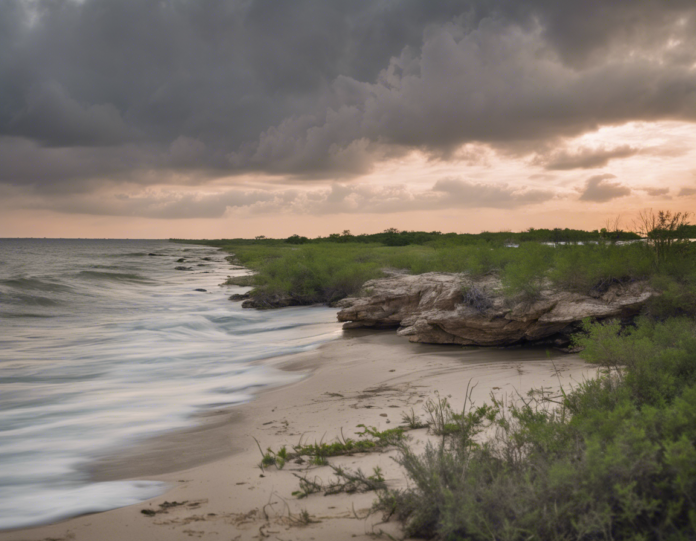Introduction
The Texas shoreline is a diverse and dynamic ecosystem that plays a crucial role in supporting a wide range of plant and animal species, as well as providing important economic and recreational opportunities for residents and visitors alike. However, in recent years, the Texas shoreline has come under increasing strain as a result of various environmental factors, including climate change, coastal erosion, and human activities. These challenges are having a significant impact on the health and resilience of the shoreline, raising concerns about the long-term sustainability of this vital ecosystem.
The Impact of Coastal Erosion
Coastal erosion is a natural process that occurs when waves, tides, and currents wear away the land along the shoreline. However, human activities such as urban development, dredging, and climate change can accelerate this process, leading to significant loss of land and habitat. In Texas, coastal erosion is a major concern, particularly along the Gulf Coast, where rising sea levels and increasingly severe storms are exacerbating the problem.
Key Factors Contributing to Shoreline Strain
-
Climate Change: One of the primary drivers of shoreline strain in Texas is climate change. Rising global temperatures are causing sea levels to rise, leading to increased flooding and coastal erosion along the shoreline.
-
Urban Development: The rapid growth of cities and towns along the Texas coast has led to increased runoff of pollutants into the water, as well as the destruction of natural habitats that help protect the shoreline from erosion.
-
Oil and Gas Exploration: Texas is home to a significant oil and gas industry, which has a major impact on the health of the shoreline. Pollution from oil spills and drilling activities can have devastating effects on marine life and habitats.
-
Overfishing: Overfishing along the Texas coast has depleted fish populations, disrupting the ecosystem and affecting the health of the shoreline.
Consequences of Shoreline Strain
The strain on the Texas shoreline has a number of negative consequences, both for the environment and for the communities that depend on it. Some of the key impacts include:
-
Loss of Habitat: Coastal erosion and other factors have led to the loss of important habitats for plant and animal species, including wetlands and mangrove forests.
-
Increased Flooding: Rising sea levels and erosion are increasing the risk of flooding in coastal communities, putting homes, businesses, and infrastructure at risk.
-
Economic Losses: The degradation of the shoreline can have significant economic consequences, including loss of tourism revenue and damage to fishing and other industries that rely on a healthy shoreline.
-
Threats to Biodiversity: The decline of the shoreline ecosystem can have serious implications for biodiversity, leading to the loss of species and disruption of ecological processes.
Mitigating Shoreline Strain
Addressing the strain on the Texas shoreline will require a comprehensive and coordinated approach that involves government, scientists, community members, and other stakeholders. Some key strategies for mitigating shoreline strain include:
-
Coastal Restoration: Restoring wetlands, dunes, and other natural habitats can help protect the shoreline from erosion and provide important ecosystem services.
-
Regulatory Policies: Implementing regulations and zoning laws that restrict coastal development and protect sensitive habitats can help reduce the strain on the shoreline.
-
Public Education: Increasing awareness about the importance of the shoreline and the impact of human activities can help encourage behavior change and sustainable practices.
-
Climate Change Adaptation: Developing strategies to adapt to the impacts of climate change, such as rising sea levels and more intense storms, will be critical for protecting the Texas shoreline.
Frequently Asked Questions (FAQs)
- What is coastal erosion, and why is it a concern for the Texas shoreline?
-
Coastal erosion is the wearing away of land along the shoreline by waves, tides, and currents. It is a concern for the Texas shoreline because it can lead to the loss of land, habitats, and infrastructure.
-
How does climate change contribute to the strain on the Texas shoreline?
-
Climate change is causing sea levels to rise and increasing the frequency and intensity of storms, leading to more erosion, flooding, and other impacts on the shoreline.
-
What are some of the ways that human activities are impacting the Texas shoreline?
-
Human activities such as urban development, oil and gas exploration, overfishing, and pollution are all contributing to the strain on the Texas shoreline.
-
Why is biodiversity important for the health of the shoreline ecosystem?
-
Biodiversity is important because it helps ecosystems function properly, including providing resilience to environmental changes and supporting important ecological processes.
-
How can individuals help mitigate the strain on the Texas shoreline?
- Individuals can help by reducing their carbon footprint, supporting sustainable seafood choices, participating in shoreline clean-up efforts, and advocating for policies that protect the shoreline.
In conclusion, the strain on the Texas shoreline is a complex and multifaceted issue that requires urgent attention and action. By addressing the key drivers of shoreline strain, implementing sustainable practices, and working together to protect this valuable ecosystem, we can help ensure a healthy and vibrant shoreline for future generations.


Recent comments